To me, one of the greatest pleasures in visiting any church is to look at the stained glass windows and, in some cases where the church is very old, imagine the awe they must have inspired in congregations for whom even crude plain glass was an unimaginable luxury. Sadly, the City churches suffered terrible damage in the Blitz and much glass was lost through blast as well as direct bomb damage. However, this destruction had two positive outcomes. Firstly, if plain glass replaced the coloured, the churches’ interiors were bathed in light and in some cases appeared more like Christopher Wren and his associates intended. Secondly, of course, they gave the opportunity to a whole new generation of artists and glass makers to display their skills, and this is where I hope you will be pleasantly surprised and perhaps inspired to visit their work.
I want to start with the great man himself, and here he is, portrayed in very lifelike manner in a window at St Lawrence Jewry in Guildhall Yard. This was his most expensive parish church project and it reopened for worship in 1677…
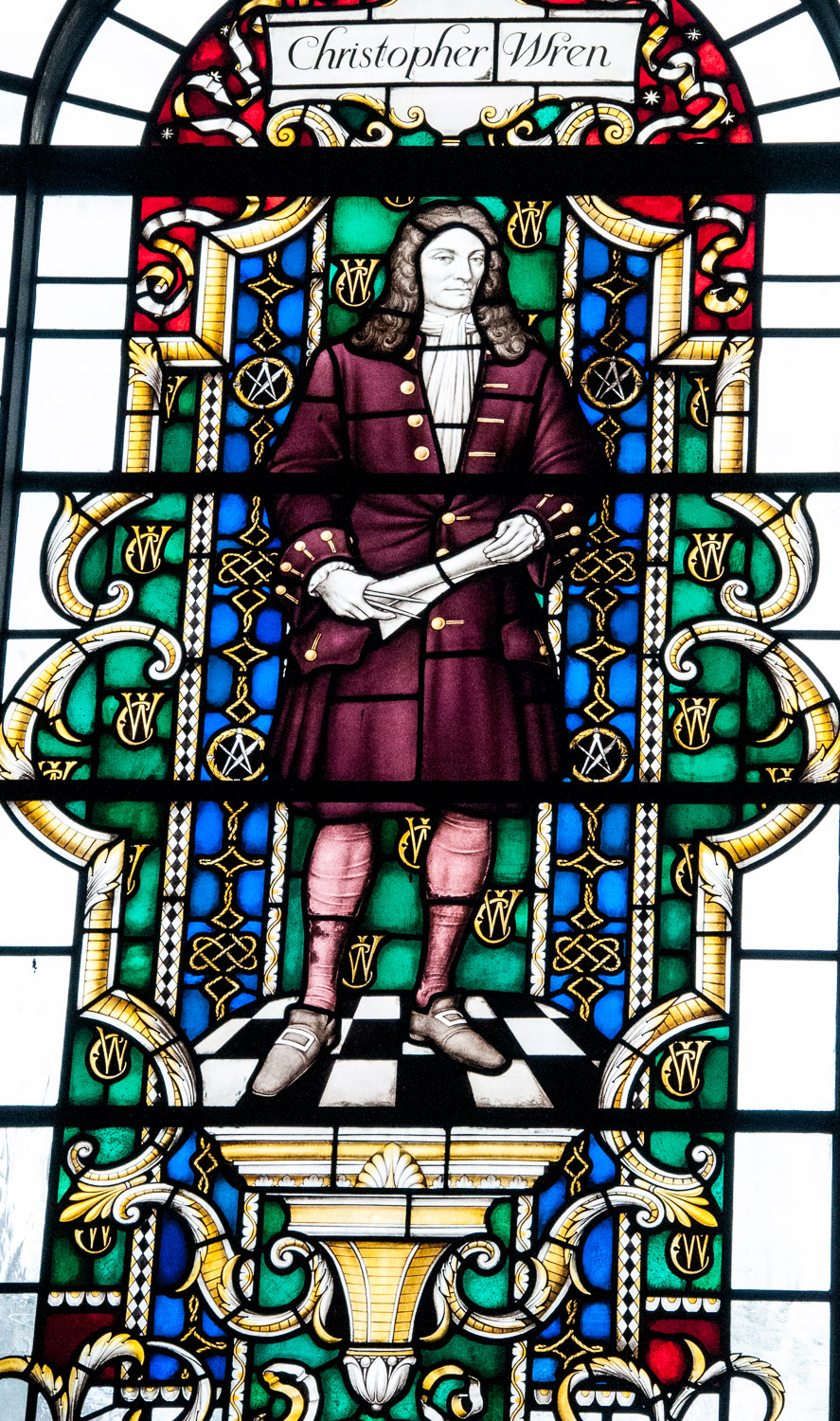
Wren enjoyed a close relationship of mutual respect with his craftsmen and it was typical of him to arrange for the foundation stones of St Paul’s Cathedral to be laid, not by himself, but by Master Mason Thomas Strong and Master Carpenter John Langland. Another Strong, Edward, pictured below, set the final stone in place at the top of the lantern on 26th October 1708, thirty three years after building commenced. Edward had succeeded his brother Thomas as Master Mason on the latter’s death in 1681.
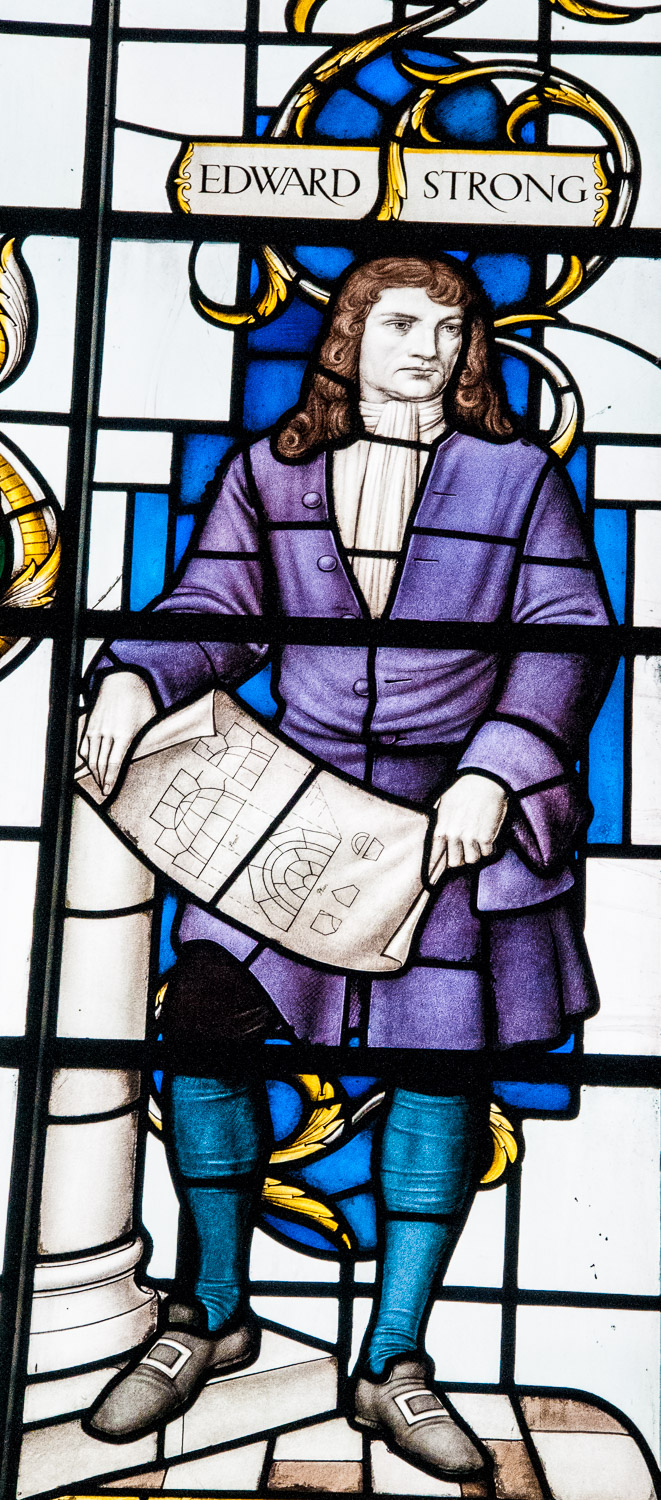
Wren’s Master Mason, Edward Strong. What a perfect name for a man who created beauty and order out of stone.
Gibbons was the greatest of decorative woodcarvers and a favourite of Wren, who also employed him on some of his country house commissions …
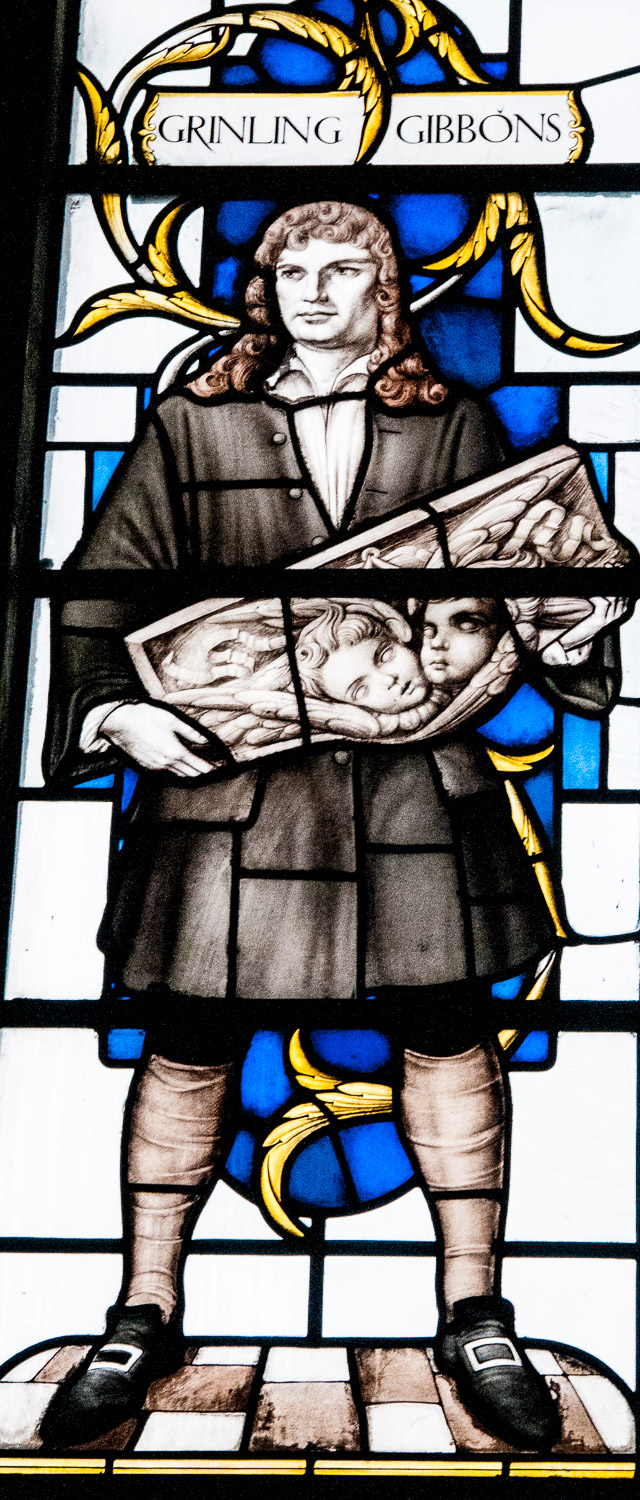
Gibbons was born in Rotterdam in 1648, arriving in England in 1670 or 1671 and evolving a distinct style that was all his own. Working mostly in limewood, Gibbons’ trademark was the cascade of fruit, leaves, flowers, foliage, fish, and birds. He was obviously also a dab hand at cherubs.
The window incorporating the three men is known as ‘The Wren Window’ …
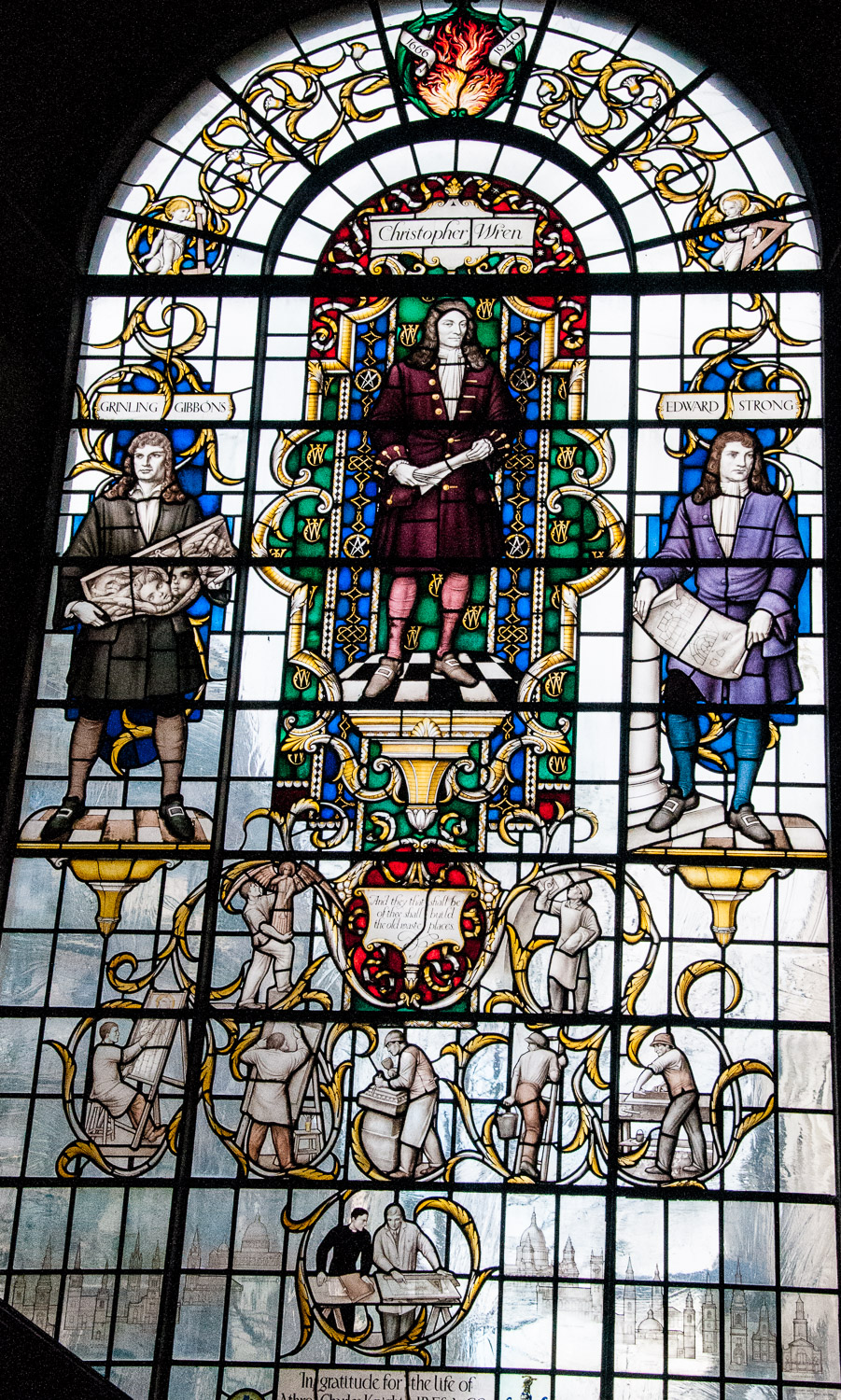
The Wren Window by Christopher Webb (1957)
Below the three major figures the window shows various craftsmen at work – bricklayers, carpenters, plasterers, stonemasons and two of his own stained glass artists.
And below them are two more modern figures …

Cecil Brown and Reverend Frank Trimingham study the church plan, with the outline of the footprint of the church in front of them. On each side are the beautifully etched towers of many of the Churches Wren built, along with two different views of St Paul’s Cathedral.
The flames remind us of two terrible years of destruction …
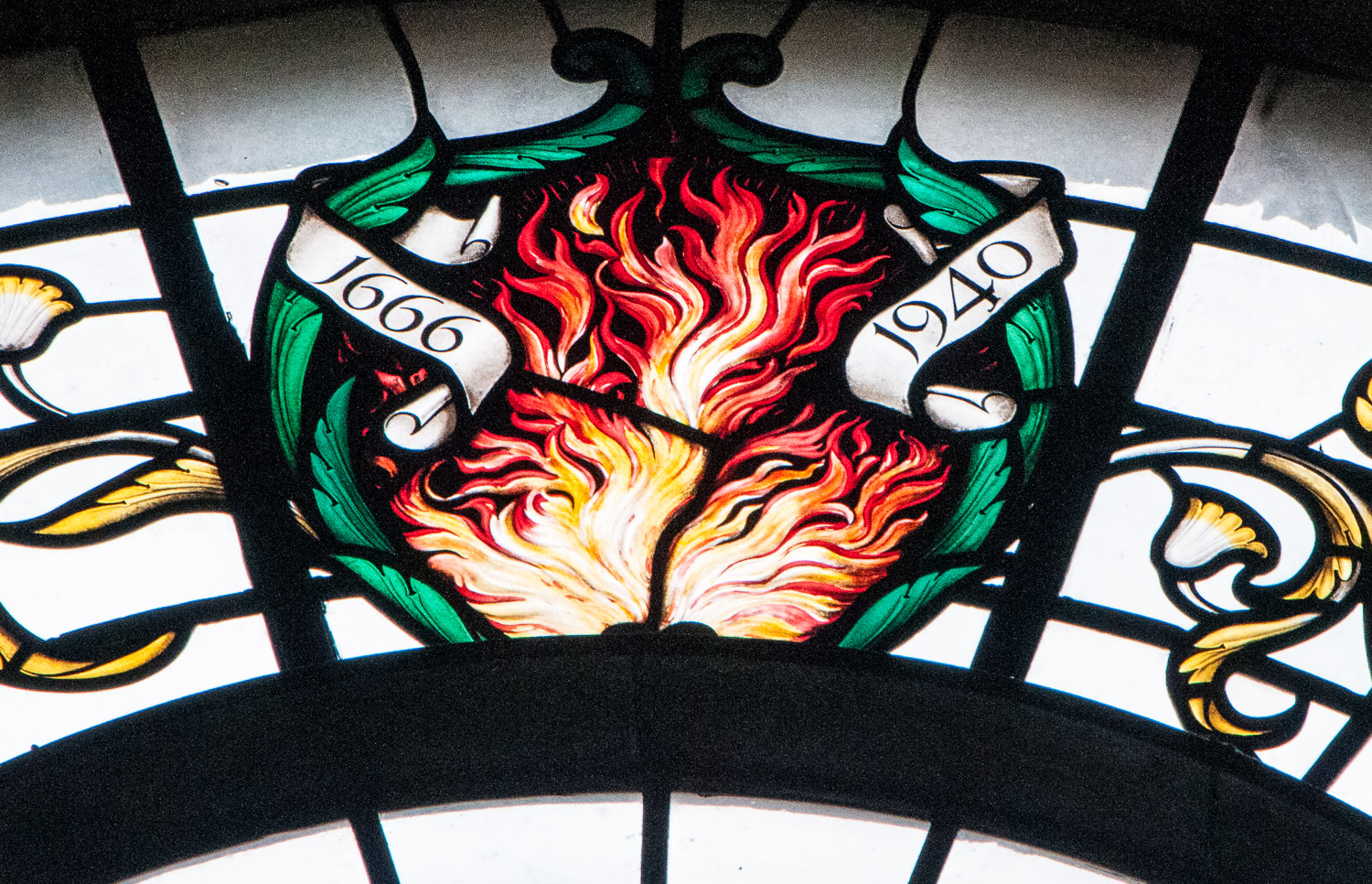
After the fire bomb raid of 29 December 1940 nothing but the tower and part of the walls remained. The present church was built in 1954-57 to the design of Cecil Brown who worked closely with Christopher Webb on the designs of the windows.
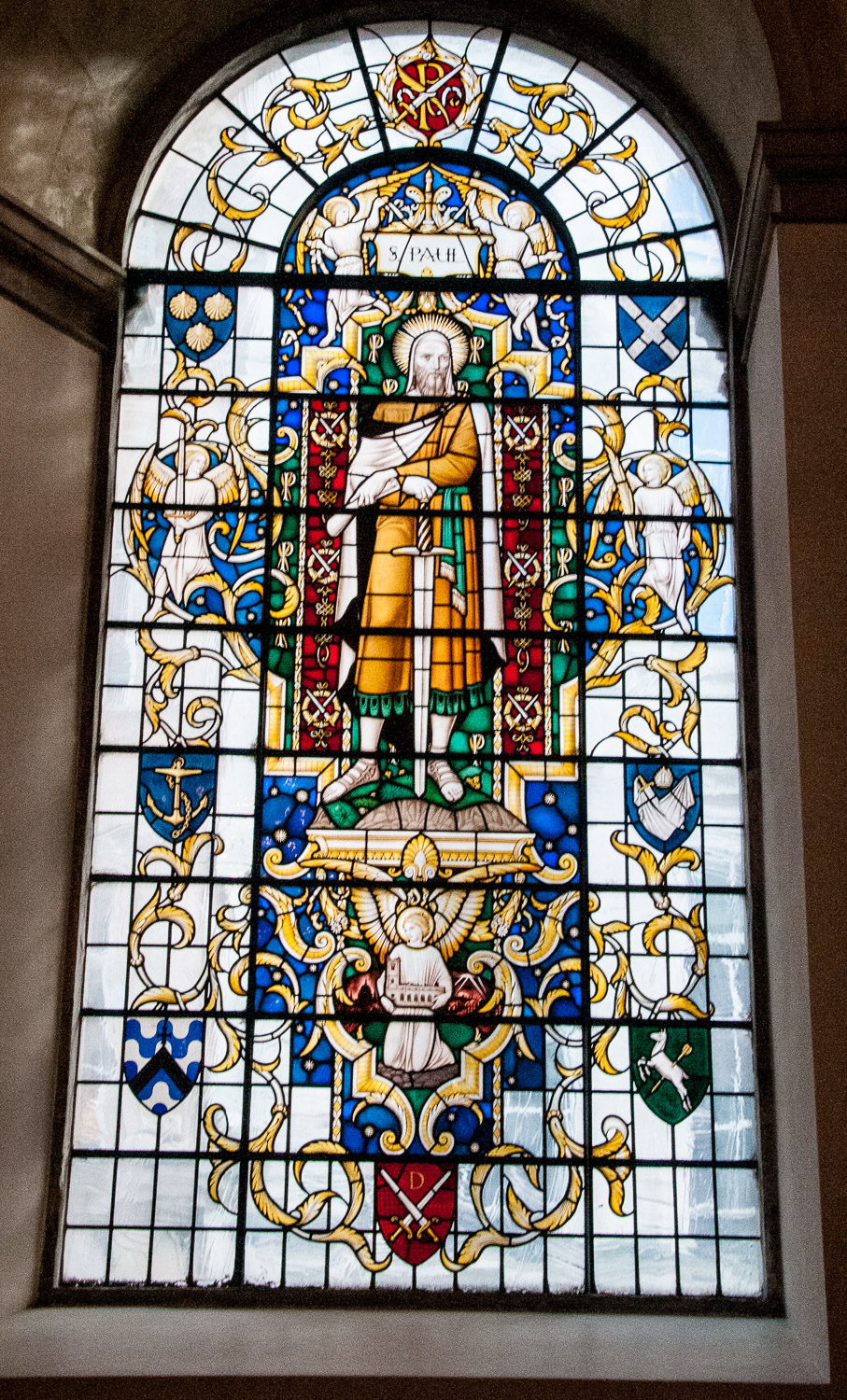
St Paul is represented here because the Dean and Chapter of St Paul’s were joint patrons from 1677 to 1954.
Note the angel at the base of the window …
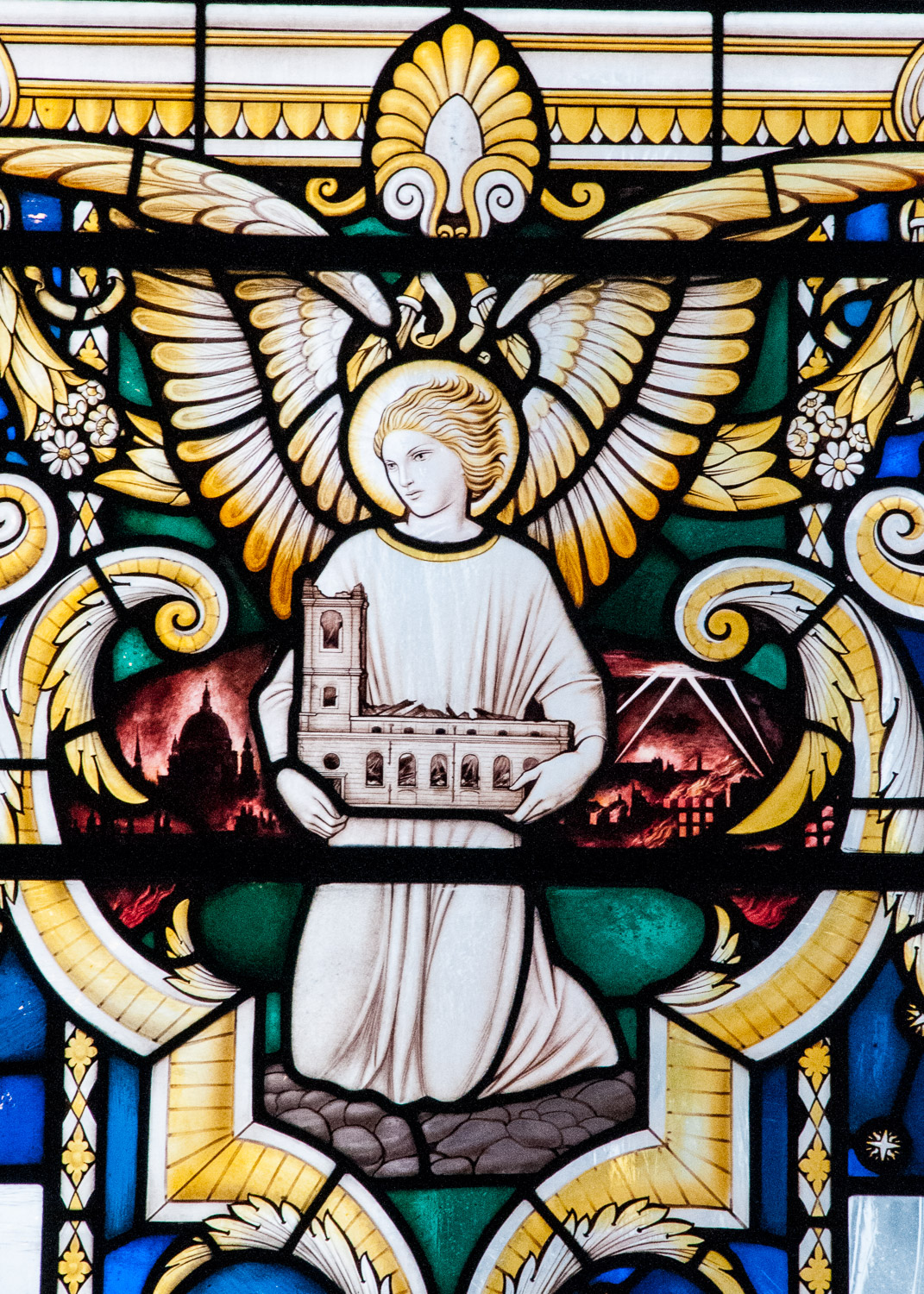
The angel is holding the shell of the destroyed church, roof and windows gone and what is left of the building filled with rubble. St Paul’s in the background is silhouetted by fire and the buildings on the right are ablaze as searchlights pierce the sky.
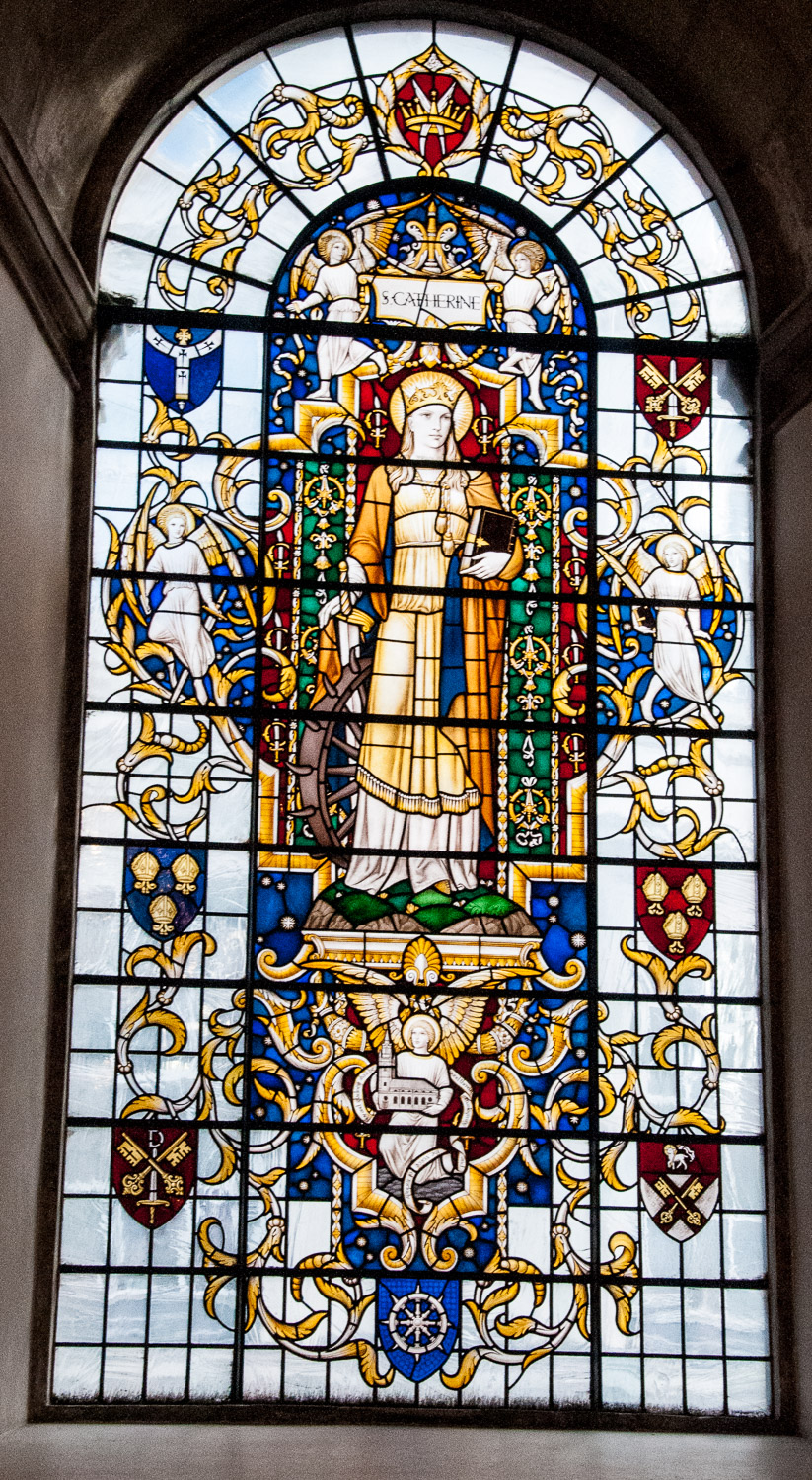
St Catharine is the patron saint of Baliol College Oxford which has had a close connection with the church since the 13th century
She is pictured with the spiked wheel on which she was tortured.
But look at the angel, again at the base of the window …
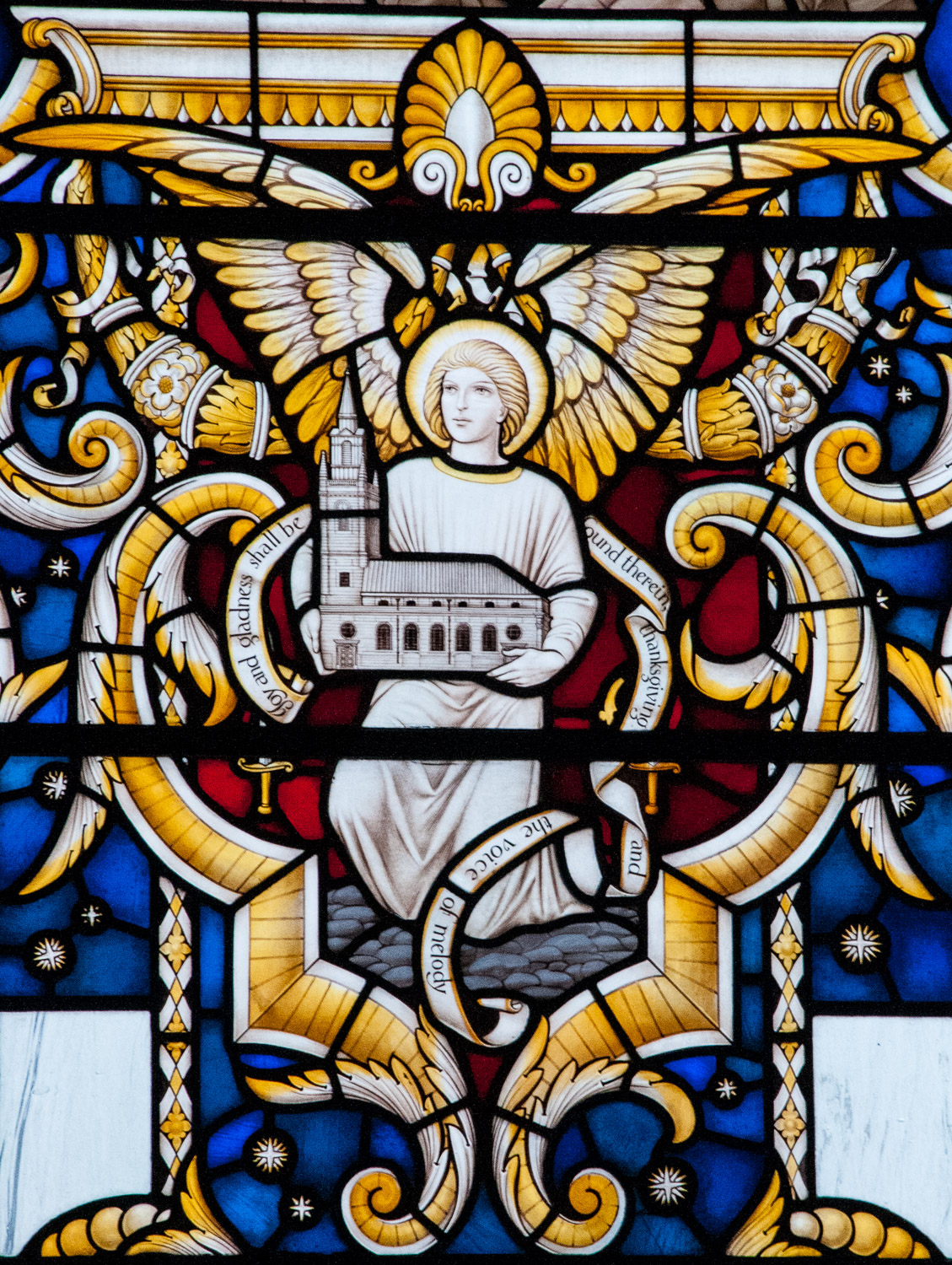
The angel is holding the restored church.
Naturally, there is a window commemorating the church’s patron saint, St Lawrence, who suffered martyrdom in 258 AD …
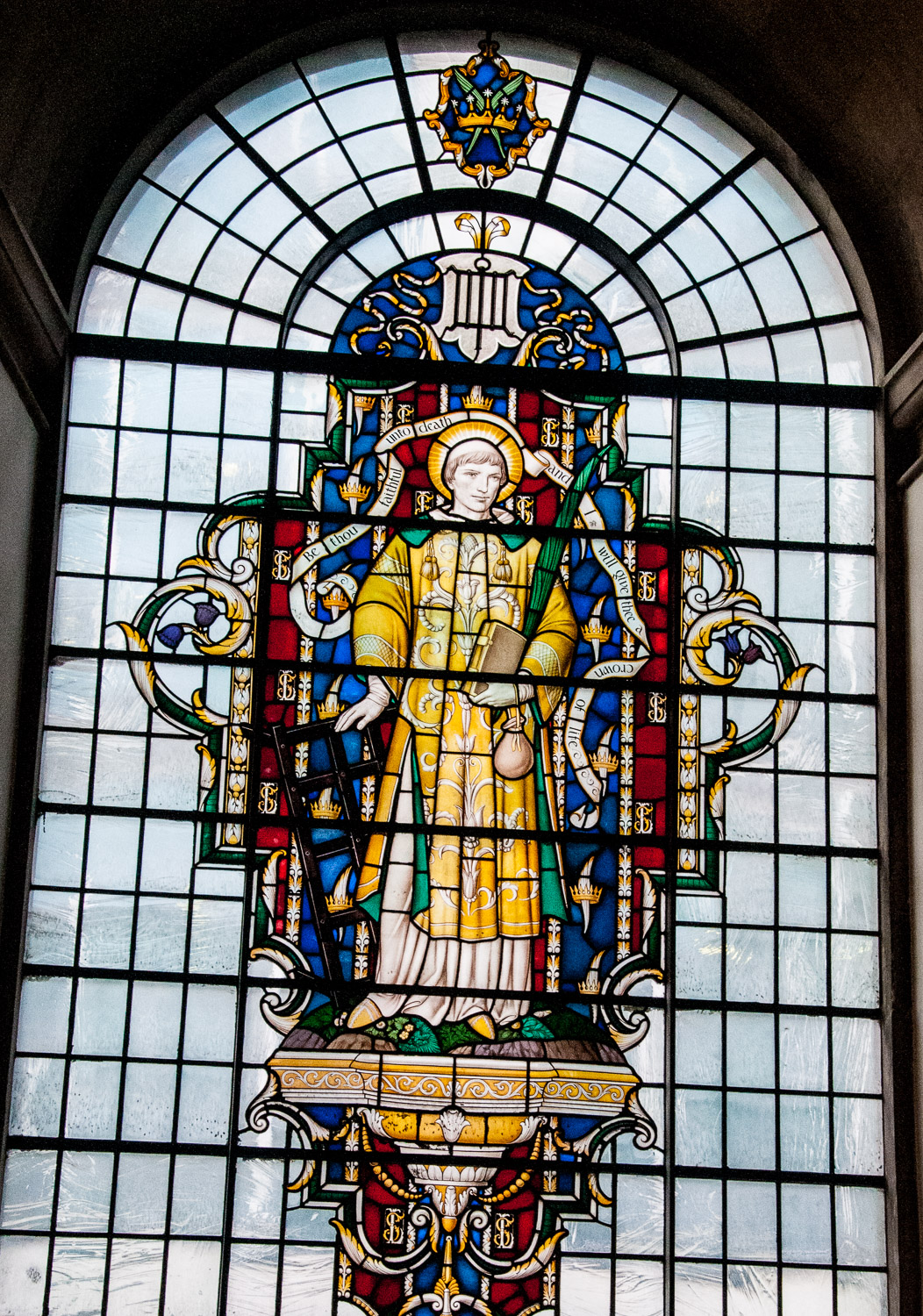
For refusing to give up the treasures of the church, represented by the purse he is carrying, he was flayed and roasted alive on a gridiron.
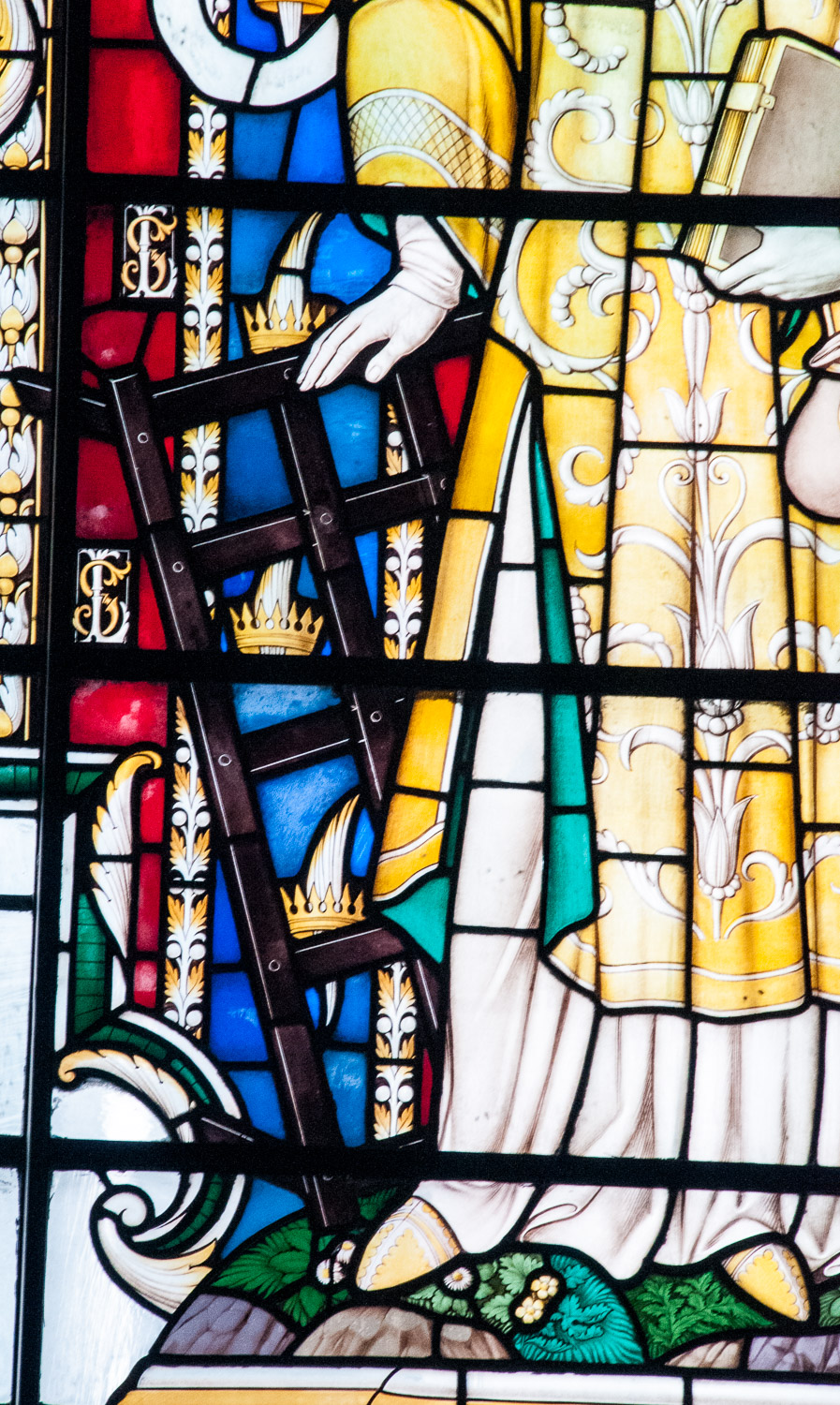
The gridiron became his symbol and appears throughout the church and on the steeple weathervane
As regular readers of this blog will know, I am very fond of St Vedast-alias-Foster in Foster Lane – I love its secluded fountain courtyard and cloister. Today, however, I am commenting on the interior, which also had to be rebuilt after the same raid that destroyed St Lawrence.
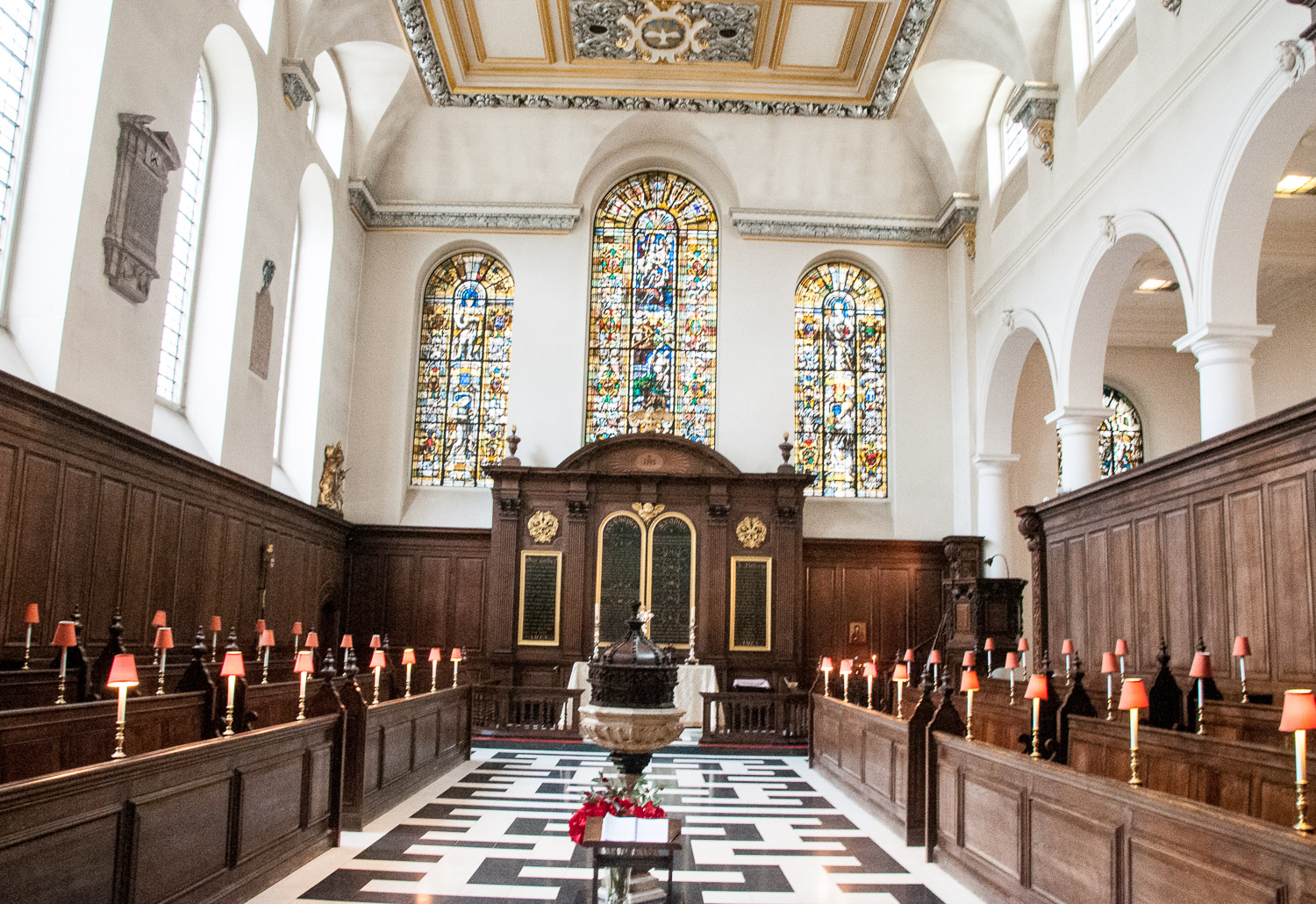
Looking towards the east end of the church
Above the reredos is the ‘Vedast Window’, with stained glass depicting scenes from the life of the saint …
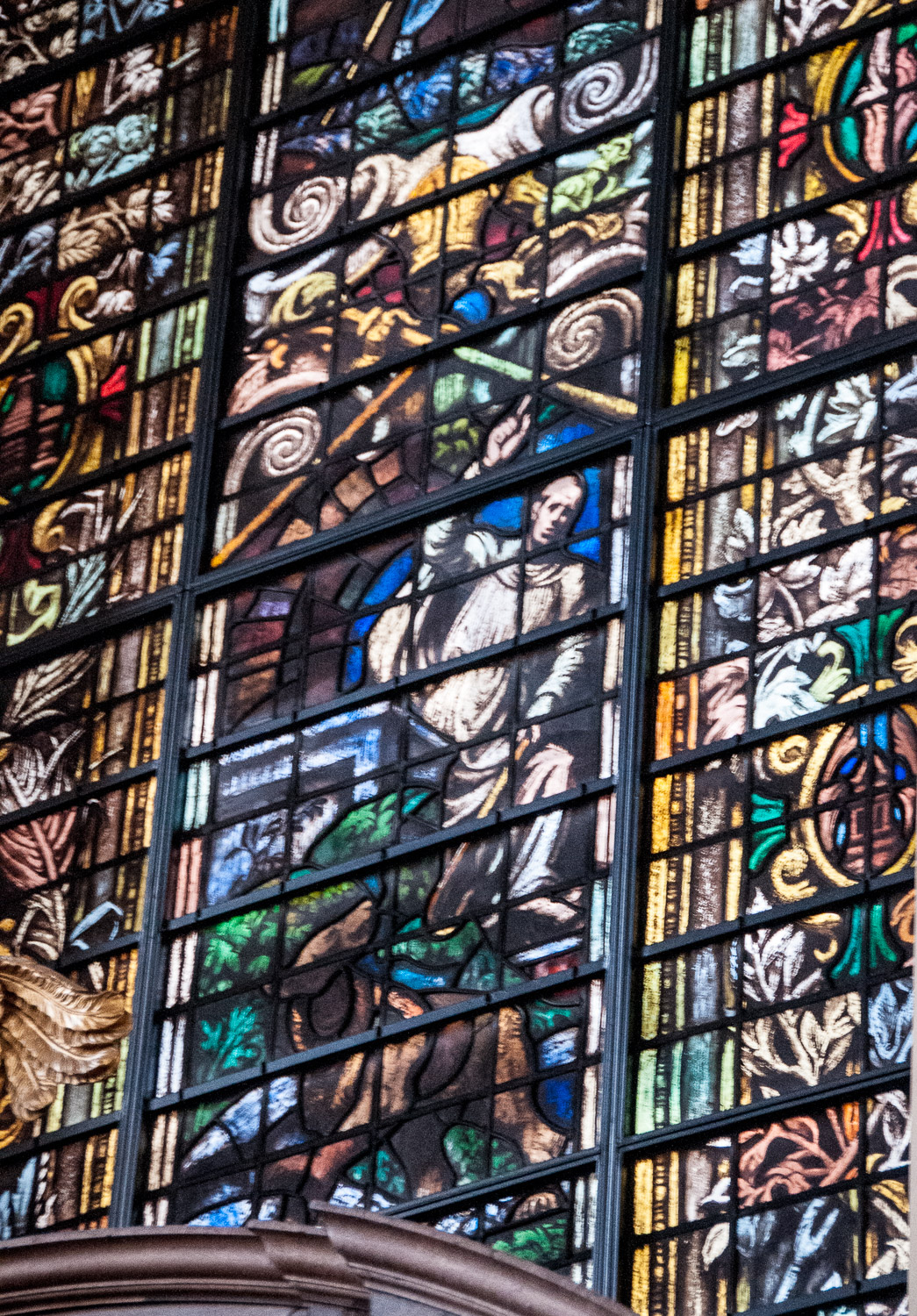
Look for the saint chasing a bear from its cave (er, no, I don’t know why either).
The glass below, in the east window of the chapel, was the only window saved after the 1940 bombing. It gives us some idea of the terrible losses incurred on that night …
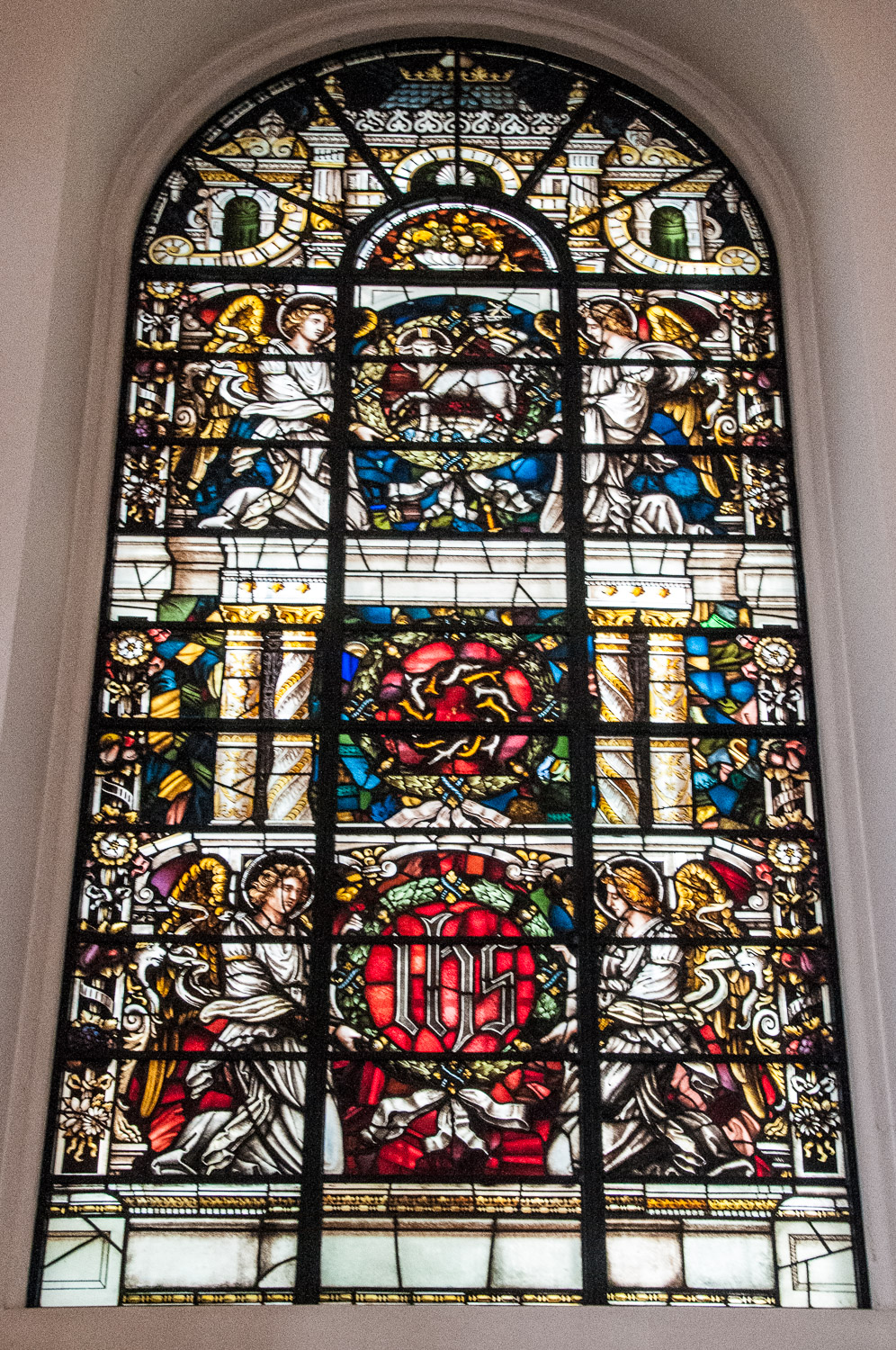
The glass is by the firm of Clayton & Bell which was founded in 1855 and continued until as recently as 1993.
When I visited the church last Friday (February 2nd) there was a magnificent display of church silver …
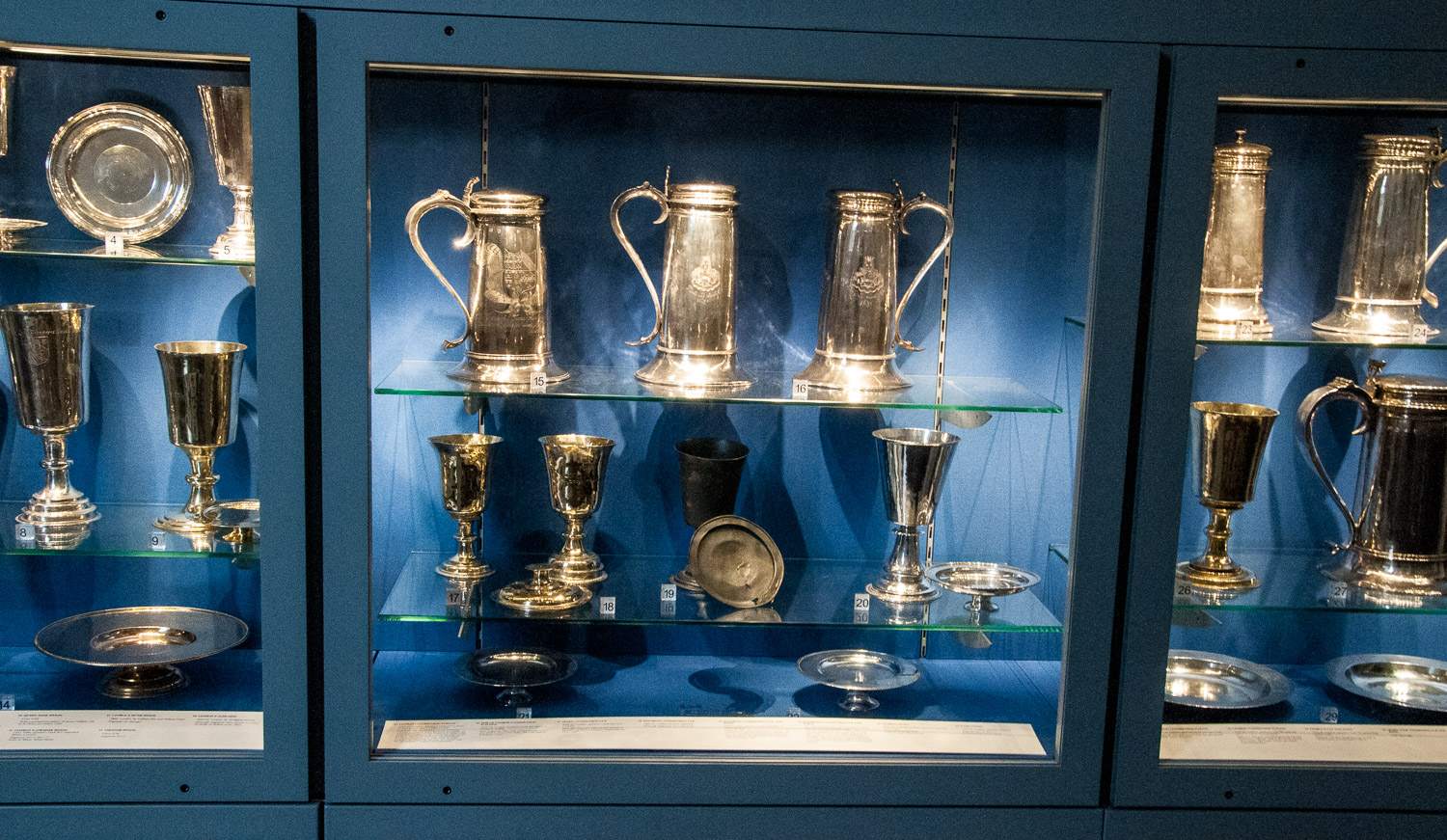
The church’s collection of silver plate dating back to the 16th century.
St Vedast is unusual among City churches in that it is open seven days a week, so you can pop in between 8:00 am and 5:30 pm on weekdays. Full details are on the website.
And now some examples of the stunning widows designed by the artist and glass maker John David Hayward, the first being in St Michael Paternoster Royal on College Hill EC4, where Dick Whittington was buried in 1423.
I’m sure everyone knows the Whittington legend. He had given up on making his fortune in London but, as he headed home with his faithful cat, he heard the bells of St Mary-le-Bow ring out the words:
Turn again Whittington, thrice Lord Mayor of London
Well, the bit about him being Lord Mayor is true, and it was four times rather than three, but two of the terms were consecutive.
Here Hayward shows that critical moment on Highgate Hill …
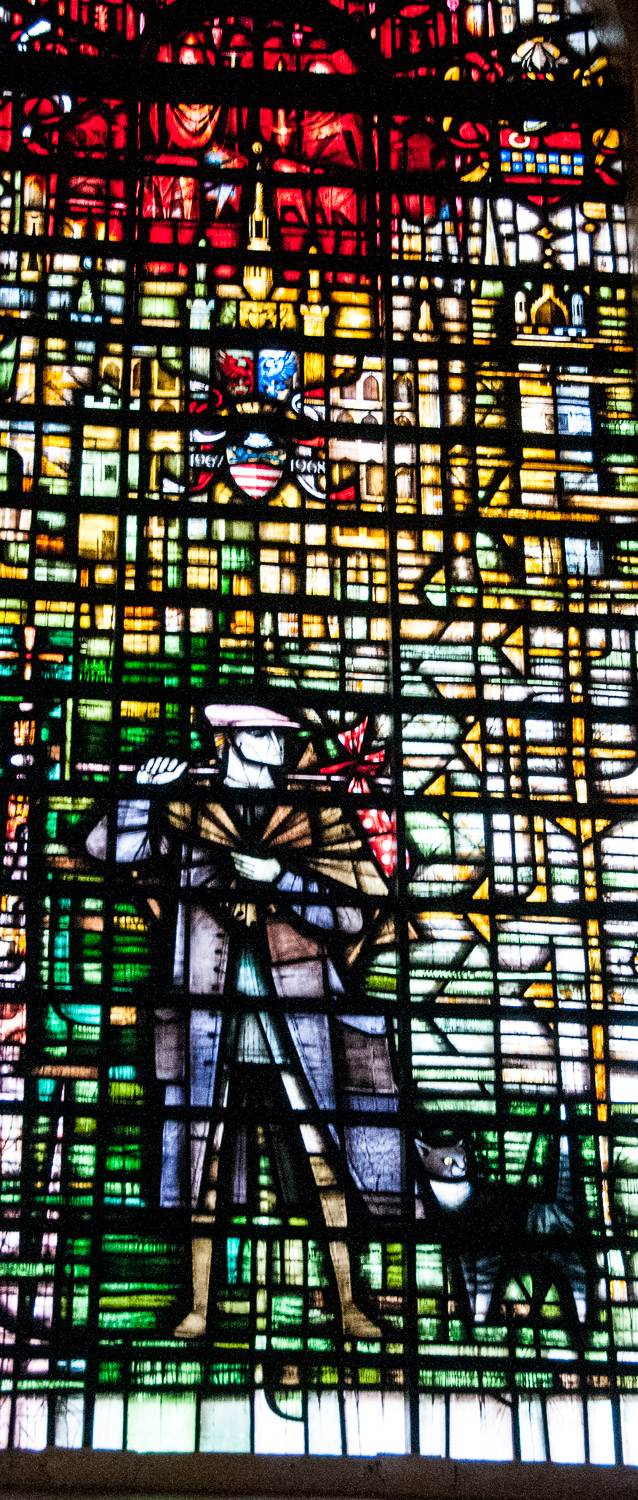
The church bells of St Mary-le-Bow ring out behind him
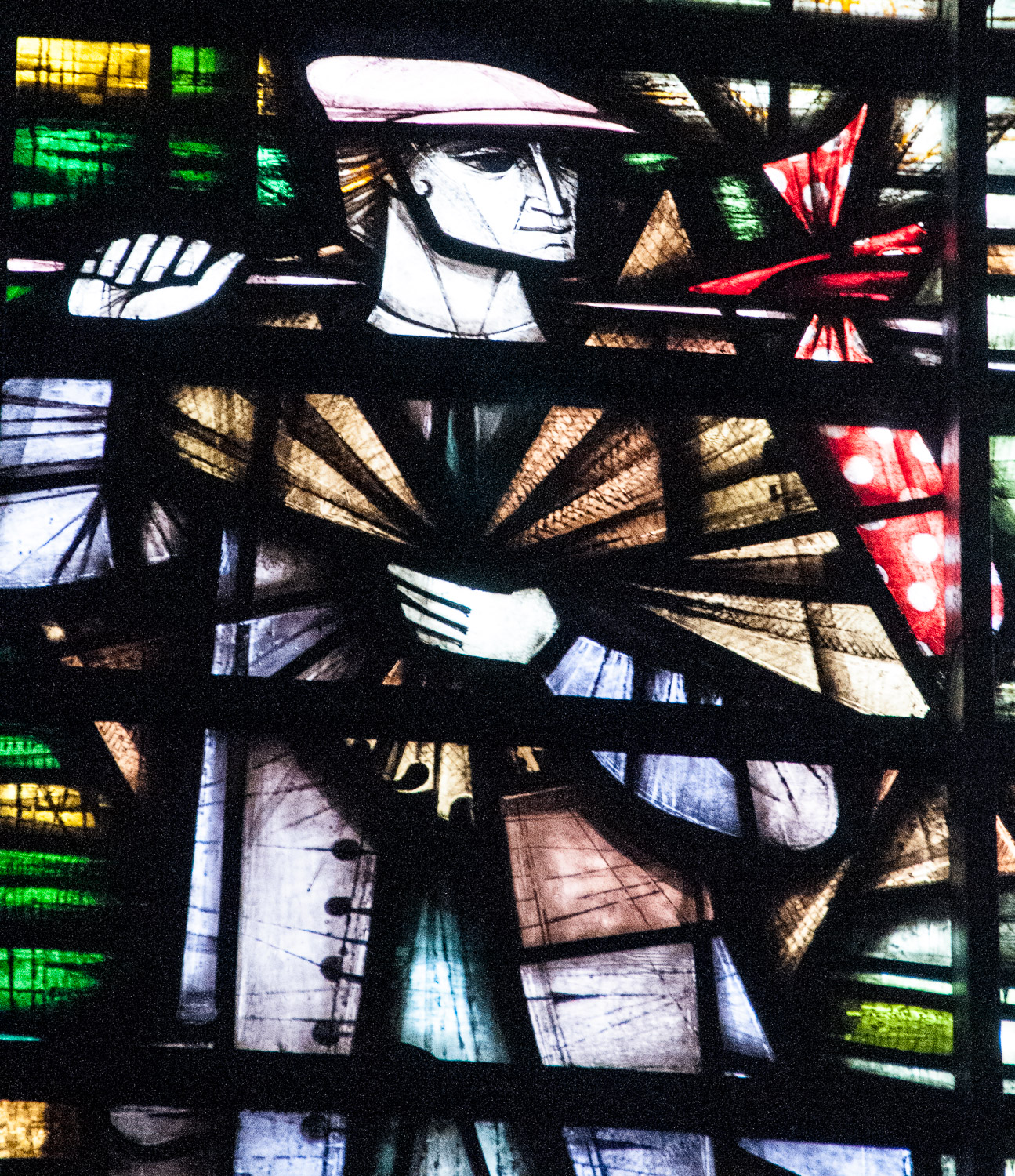
I think he rather resembles a flat-capped Hoxton Hipster – maybe there is an iPad in that bag.
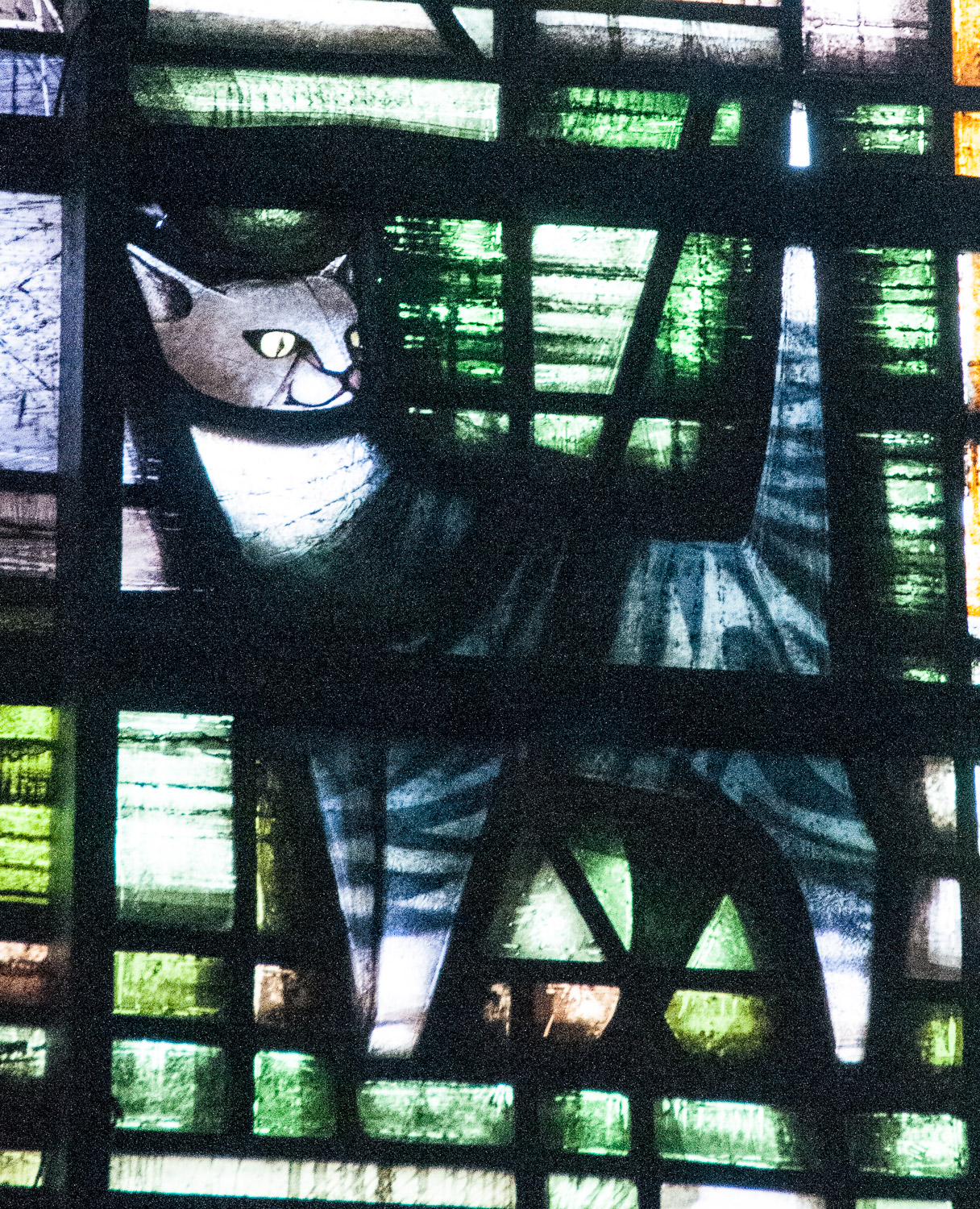
I love the expression on the cat’s face. Perhaps he has seen a mouse.
You can read more about the legend at the wonderful Purr ‘n’ Fur website, ‘Fabled Felines. Cats in Fables, Fairytales and Festivals’.
In another window St Michael slaughters the serpent …
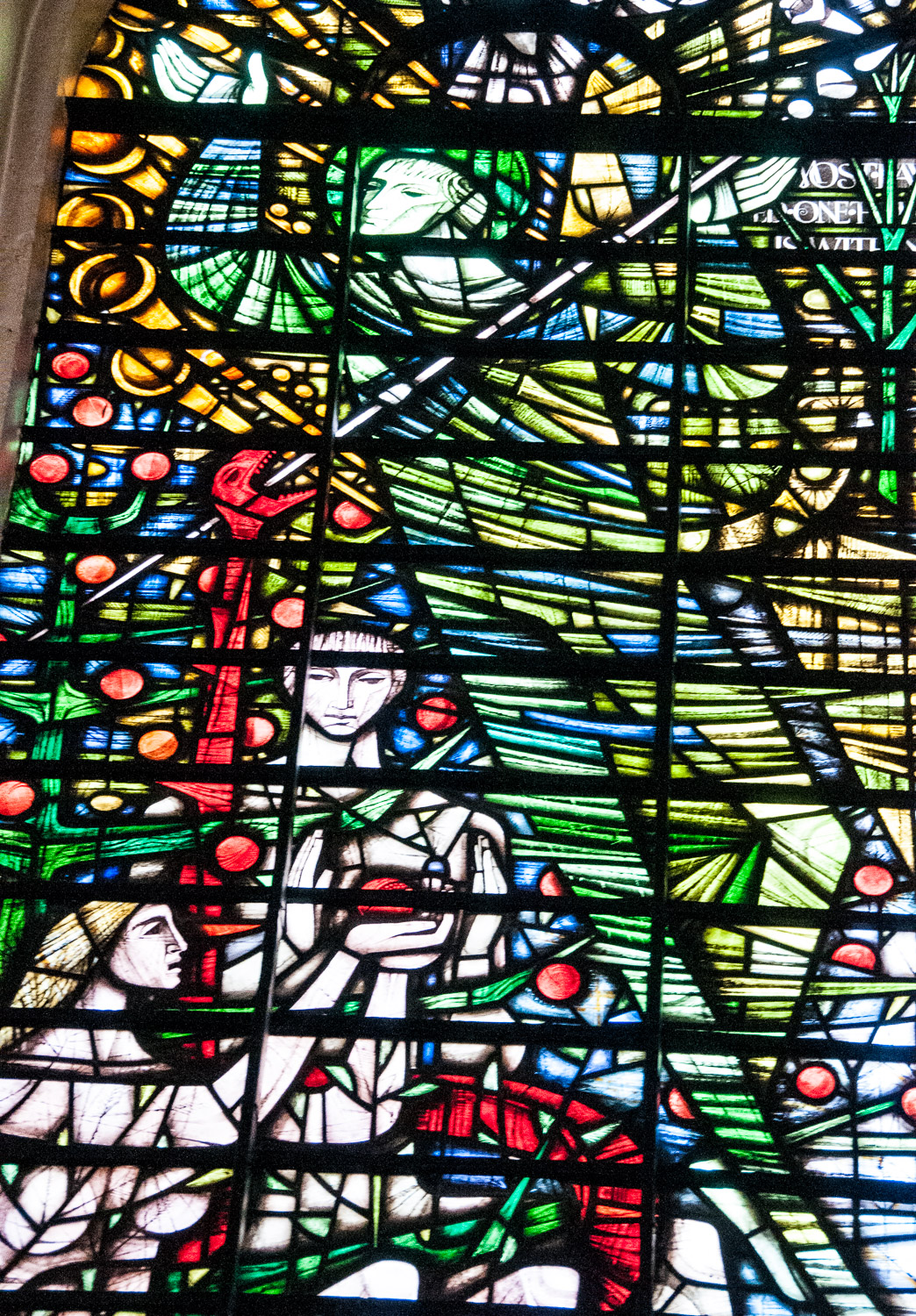
… but too late, Eve has already presented Adam with the apple.
And so now to the church whose bells summoned Whittington back to the City, St Mary-le-Bow in Cheapside, Hayward’s first major commission. Look out for livery company coats of arms …
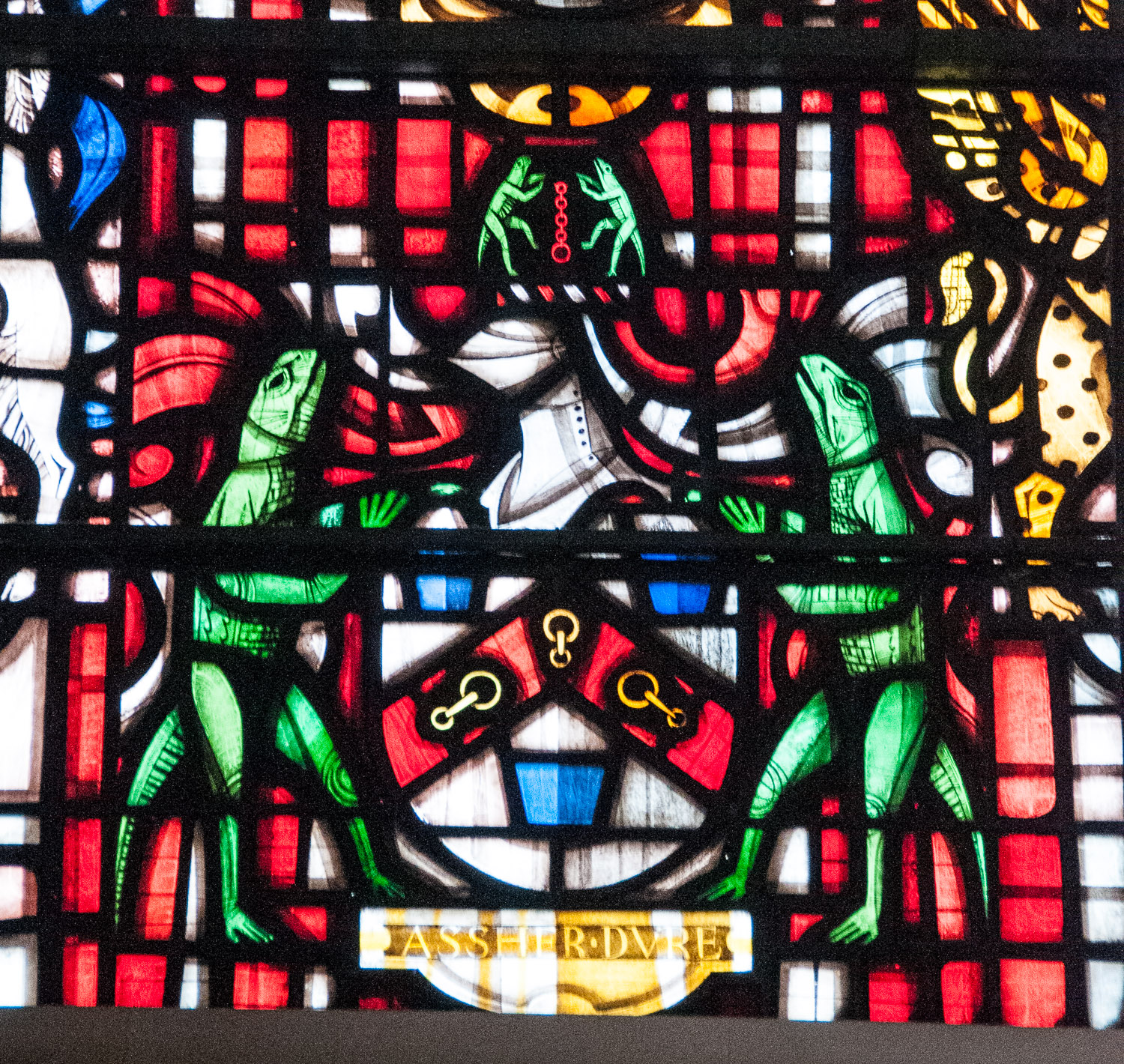
The salamanders of the Worshipful Company of Ironmongers – reputedly able to survive fire
In the window pictured below St Paul, patron of the City, is surrounded by the Wren churches that survived World War II with St Paul’s Cathedral in the top right hand corner …
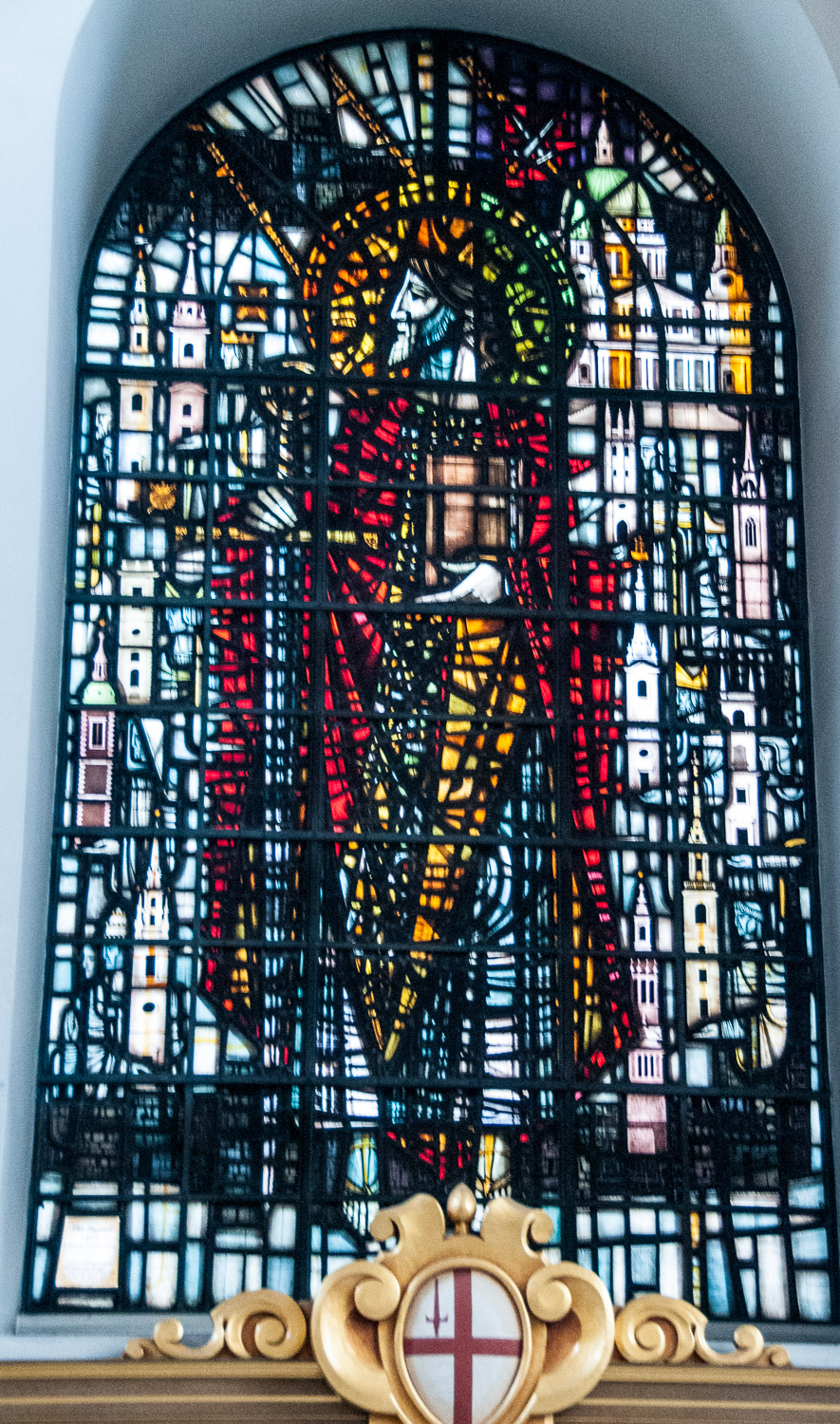
Here the Virgin Mary cradles the church named after her as if it were a child, also surrounded by church spires that survived the Blitz …
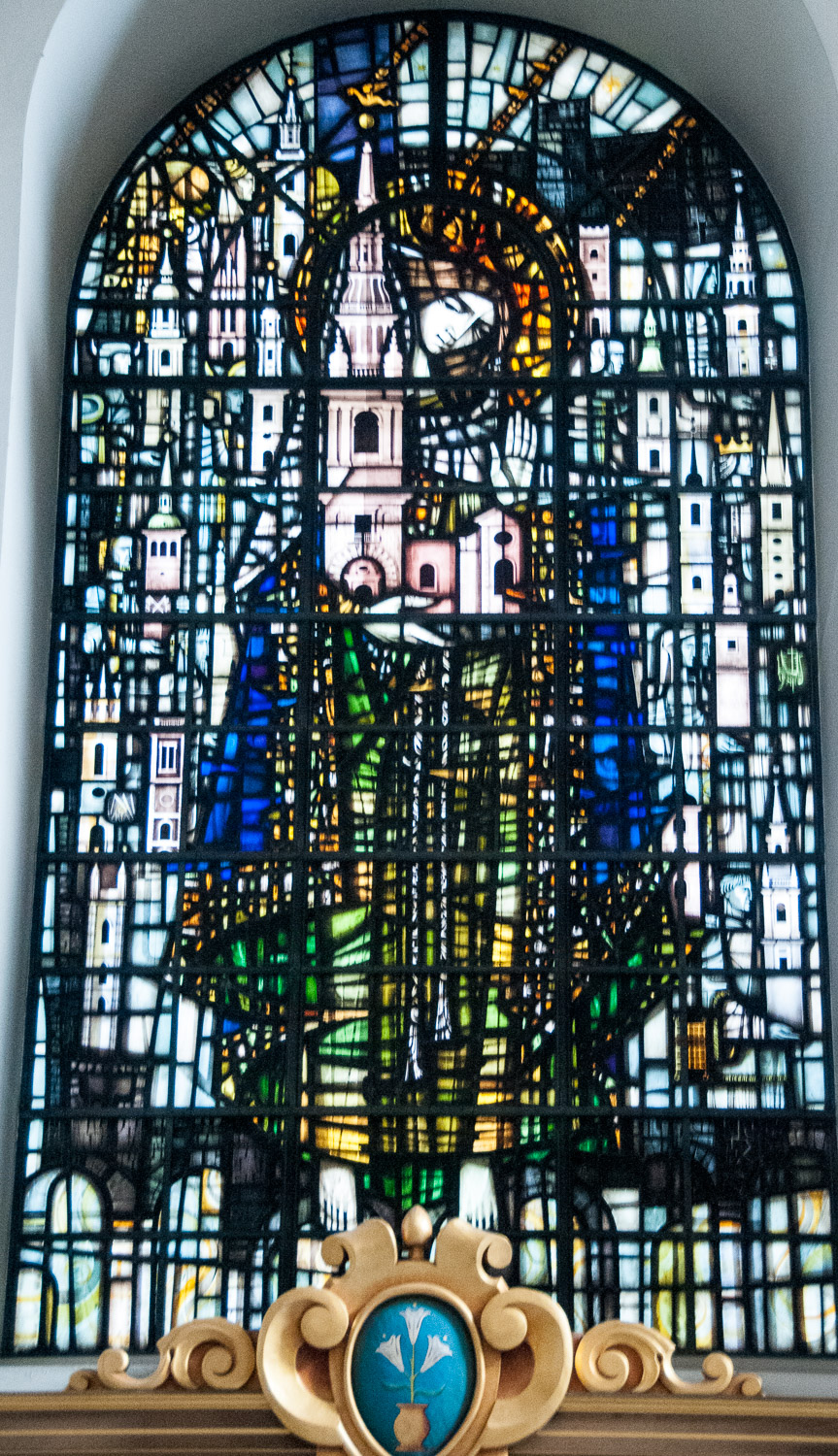
She is standing on the bow-shaped arches on which are based the church’s suffix ‘le Bow’.
Christopher Webb died in 1966 and John David Hayward in 2007, both leaving a beautiful legacy. I hope you will at some point enjoy visiting their work as much as I have.
I shall end today’s blog with a quote by Marc Chagall …
For me a stained glass window is a transparent partition between my heart and the heart of the world
